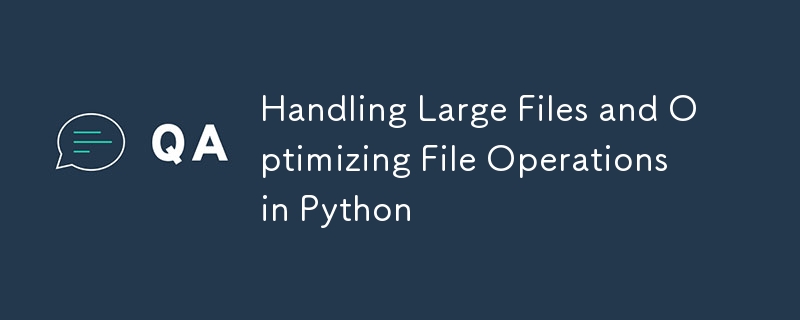
在這個部落格系列中,我們將探索如何在 Python 中處理文件,從基礎開始,逐步進展到更高級的技術。
在本系列結束時,您將對 Python 中的文件操作有深入的了解,使您能夠有效地管理和操作文件中儲存的資料。
系列將由五篇文章組成,每篇文章都建立在上一篇文章的知識之上:
隨著 Python 專案的成長,您可能會處理無法輕鬆同時載入到記憶體中的大檔案。
高效處理大型檔案對於效能至關重要,尤其是在處理可能達到數 GB 的資料處理任務、日誌檔案或資料集時。
在這篇文章中,我們將探索在 Python 中讀取、寫入和處理大檔案的策略,確保您的應用程式保持回應速度和高效。
處理大型檔案時,您可能會遇到幾個挑戰:
為了應對這些挑戰,您需要能夠在不影響效能或穩定性的情況下處理大檔案的策略。
處理大檔案的最佳方法之一是以較小的區塊讀取它們,而不是將整個檔案載入到記憶體中。
Python 提供了多種技術來實現此目的。
逐行讀取檔案是處理大型文字檔案最節省記憶體的方法之一。
這種方法會在讀取時處理每一行,使您可以處理幾乎任何大小的檔案。
# Open the file in read mode
with open('large_file.txt', 'r') as file:
# Read and process the file line by line
for line in file:
# Process the line (e.g., print, store, or analyze)
print(line.strip())
在此範例中,我們使用 for 迴圈逐行讀取檔案。
strip() 方法刪除任何前導或尾隨空格,包括換行符。
此方法非常適合處理日誌檔案或資料集,其中每行代表一個單獨的記錄。
在某些情況下,您可能想要以固定大小的區塊讀取文件,而不是逐行讀取。
這在處理二進位檔案或需要處理資料區塊中的檔案時非常有用。
# Define the chunk size
chunk_size = 1024 # 1 KB
# Open the file in read mode
with open('large_file.txt', 'r') as file:
# Read the file in chunks
while True:
chunk = file.read(chunk_size)
if not chunk:
break
# Process the chunk (e.g., print or store)
print(chunk)
在此範例中,我們指定 1 KB 的區塊大小並以該大小的區塊讀取檔案。
while 迴圈繼續讀取,直到沒有更多資料可供讀取(區塊為空)。
此方法對於處理大型二進位檔案或需要使用特定位元組範圍時特別有用。
就像讀取一樣,高效寫入大檔案對於效能至關重要。
分塊或批次寫入資料可以防止記憶體問題並提高操作速度。
將大量資料寫入檔案時,分塊寫入比逐行寫入更有效,尤其是在處理二進位資料或產生大型文字檔案時。
data = ["Line 1\n", "Line 2\n", "Line 3\n"] * 1000000 # Example large data
# Open the file in write mode
with open('large_output_file.txt', 'w') as file:
for i in range(0, len(data), 1000):
# Write 1000 lines at a time
file.writelines(data[i:i+1000])
在此範例中,我們產生一個大的行列表,並將它們以 1000 行為一組批次寫入到文件中。
這種方法比單獨編寫每一行更快、更節省記憶體。
除了有效率地讀寫資料之外,您還可以使用其他幾種最佳化技術來更有效地處理大型檔案。
Python 的eek() 和tell() 函數可讓您在檔案中導航,而無需讀取整個內容。
這對於跳到大檔案的特定部分或從某個點恢復操作特別有用。
Example: Navigating a File with seek() and tell()# Open the file in read mode
with open('large_file.txt', 'r') as file:
# Move the cursor 100 bytes from the start of the file
file.seek(100)
# Read and print the next line
line = file.readline()
print(line)
# Get the current cursor position
position = file.tell()
print(f"Current position: {position}")
In this example, we move the cursor 100 bytes into the file using seek() and then read the next line.
The tell() function returns the cursor's current position, allowing you to track where you are in the file.
For handling large binary files, Python’s memoryview object allows you to work with slices of a binary file without loading the entire file into memory.
This is particularly useful when you need to modify or analyze large binary files.
Example: Using memoryview with Binary Files# Open a binary file in read mode
with open('large_binary_file.bin', 'rb') as file:
# Read the entire file into a bytes object
data = file.read()
# Create a memoryview object
mem_view = memoryview(data)
# Access a slice of the binary data
slice_data = mem_view[0:100]
# Process the slice (e.g., analyze or modify)
print(slice_data)
In this example, we read a binary file into a bytes object and create a memoryview object to access a specific slice of the data.
This allows you to work with large files more efficiently by minimizing memory usage.
Handling large files in Python doesn’t have to be a daunting task.
By reading and writing files in chunks, optimizing file navigation with seek() and tell(), and using tools like memoryview, you can efficiently manage even the largest files without running into performance issues.
In the next post, we’ll discuss how to make your file operations more robust by using context managers and exception handling.
These techniques will help ensure that your file-handling code is both efficient and reliable, even in the face of unexpected errors.
以上是Python 中處理大檔案並優化檔案操作的詳細內容。更多資訊請關注PHP中文網其他相關文章!




